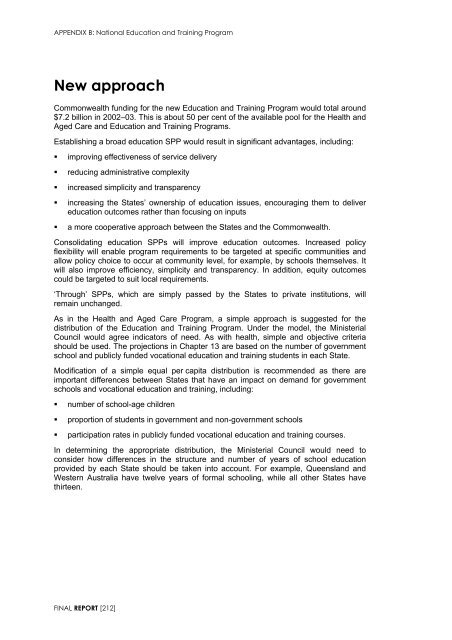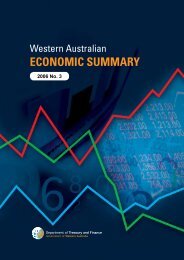Garnaut Fitzgerald Review of Commonwealth-State Funding
Garnaut Fitzgerald Review of Commonwealth-State Funding
Garnaut Fitzgerald Review of Commonwealth-State Funding
You also want an ePaper? Increase the reach of your titles
YUMPU automatically turns print PDFs into web optimized ePapers that Google loves.
APPENDIX B: National Education and Training Program<br />
New approach<br />
<strong>Commonwealth</strong> funding for the new Education and Training Program would total around<br />
$7.2 billion in 2002–03. This is about 50 per cent <strong>of</strong> the available pool for the Health and<br />
Aged Care and Education and Training Programs.<br />
Establishing a broad education SPP would result in significant advantages, including:<br />
• improving effectiveness <strong>of</strong> service delivery<br />
• reducing administrative complexity<br />
• increased simplicity and transparency<br />
• increasing the <strong>State</strong>s’ ownership <strong>of</strong> education issues, encouraging them to deliver<br />
education outcomes rather than focusing on inputs<br />
• a more cooperative approach between the <strong>State</strong>s and the <strong>Commonwealth</strong>.<br />
Consolidating education SPPs will improve education outcomes. Increased policy<br />
flexibility will enable program requirements to be targeted at specific communities and<br />
allow policy choice to occur at community level, for example, by schools themselves. It<br />
will also improve efficiency, simplicity and transparency. In addition, equity outcomes<br />
could be targeted to suit local requirements.<br />
‘Through’ SPPs, which are simply passed by the <strong>State</strong>s to private institutions, will<br />
remain unchanged.<br />
As in the Health and Aged Care Program, a simple approach is suggested for the<br />
distribution <strong>of</strong> the Education and Training Program. Under the model, the Ministerial<br />
Council would agree indicators <strong>of</strong> need. As with health, simple and objective criteria<br />
should be used. The projections in Chapter 13 are based on the number <strong>of</strong> government<br />
school and publicly funded vocational education and training students in each <strong>State</strong>.<br />
Modification <strong>of</strong> a simple equal per capita distribution is recommended as there are<br />
important differences between <strong>State</strong>s that have an impact on demand for government<br />
schools and vocational education and training, including:<br />
• number <strong>of</strong> school-age children<br />
• proportion <strong>of</strong> students in government and non-government schools<br />
• participation rates in publicly funded vocational education and training courses.<br />
In determining the appropriate distribution, the Ministerial Council would need to<br />
consider how differences in the structure and number <strong>of</strong> years <strong>of</strong> school education<br />
provided by each <strong>State</strong> should be taken into account. For example, Queensland and<br />
Western Australia have twelve years <strong>of</strong> formal schooling, while all other <strong>State</strong>s have<br />
thirteen.<br />
FINAL REPORT [212]

















